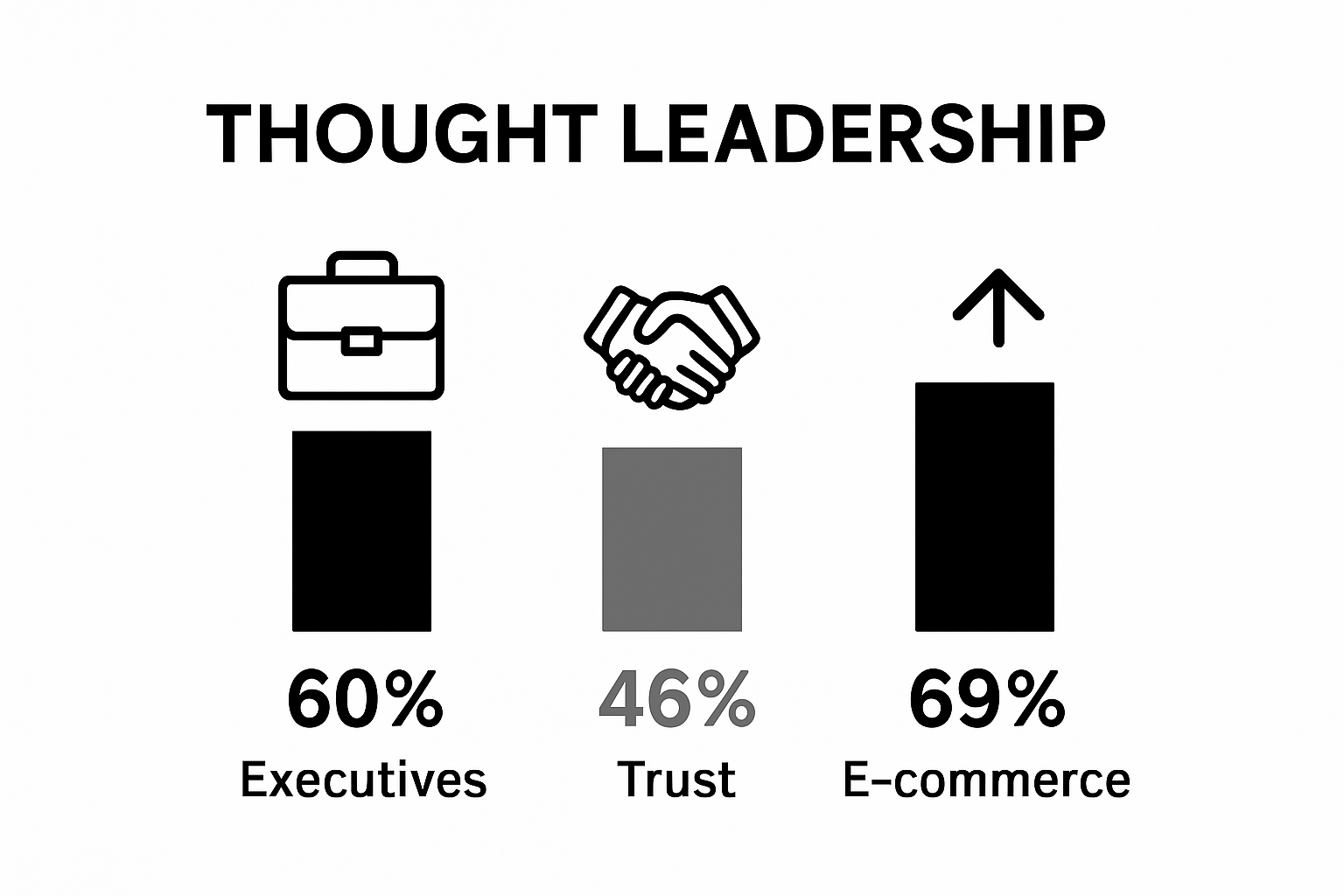Understanding Thought Leadership Marketing for Brands
Thought leadership marketing sounds like it belongs in corporate boardrooms, but its impact stretches far beyond buzzwords. Did you know that 75 percent of business executives say thought leadership content shapes how they view a brand? Most people expect thought leadership to be all about showing off, but the real secret is that it is about offering valuable knowledge and building trust, not just selling a product.
Table of Contents
- What Is Thought Leadership Marketing?
- The Importance Of Thought Leadership In E-commerce
- Key Concepts Behind Effective Thought Leadership
- How Thought Leadership Marketing Works In Practice
- Real-World Examples Of Successful Thought Leadership Strategies
Quick Summary
| Takeaway | Explanation |
|---|---|
| Establish authority through expert insights | Brands should share unique ideas to build credibility and trust in their industry. |
| Focus on educational content, not promotion | Content should educate audiences rather than simply selling products, transforming marketing communication. |
| Develop genuine expertise for authenticity | Brands must showcase true knowledge and experience to maintain credibility and trustworthiness. |
| Engage meaningfully with audiences | Actively participate in discussions and respond to questions to foster deeper customer connections. |
| Utilize diverse content formats for effectiveness | Employ various media such as reports, webinars, and podcasts to reach different audience preferences and needs. |
What is Thought Leadership Marketing?
Thought leadership marketing represents a strategic approach where brands establish credibility and authority by sharing unique, expert insights within their industry. Unlike traditional marketing that focuses on selling products, this method prioritizes generating valuable intellectual content that positions an organization as a trusted knowledge source.
Defining Core Characteristics
Thought leadership marketing fundamentally transforms how brands communicate with their audience. According to research from SAGE Open, this approach goes beyond conventional promotional tactics by emphasizing original perspectives and forward-thinking ideas.
Key characteristics of effective thought leadership marketing include:
The table below summarizes the core characteristics and foundational elements that define effective thought leadership marketing for brands.
| Characteristic | Description |
|---|---|
| Demonstrates Deep Expertise | Showcases in-depth knowledge within a specific domain |
| Provides Innovative Solutions | Offers original strategies and solutions for industry challenges |
| Creates Educational Content | Focuses on teaching and informing, rather than directly promoting products |
| Establishes Genuine Credibility | Builds trust through substantive insights and authentic communications |
| Maintains Intellectual Honesty | Addresses both challenges and potential shortcomings transparently |
| Presents Nuanced Perspectives | Goes beyond surface-level commentary to provide unique, well-researched viewpoints |
| Delivers Consistent, High-Quality Content | Publishes valuable, original material regularly to support audience learning |
- Demonstrating deep expertise in a specific domain
- Providing innovative solutions to complex industry challenges
- Creating content that educates rather than directly sells
- Establishing genuine credibility through substantive insights
Strategic Knowledge Positioning
Successful thought leadership marketing requires brands to move beyond surface-level content. It demands developing nuanced, expert-level perspectives that showcase intellectual depth. Brands must consistently produce high-quality content that reflects genuine understanding and offers meaningful contributions to industry dialogues.
This approach helps organizations build strategic brand narratives that transcend traditional marketing boundaries. By sharing sophisticated insights, companies can attract audiences seeking substantive information, not just promotional messaging.
The ultimate goal is transforming a brand from a mere product or service provider into a recognized authority that drives industry conversations and influences strategic thinking.
The Importance of Thought Leadership in E-commerce
In the competitive digital marketplace, thought leadership has emerged as a critical strategy for e-commerce brands seeking to differentiate themselves and build meaningful connections with customers. By developing authoritative content and demonstrating deep industry expertise, online businesses can transform their marketing approach from transactional to genuinely valuable.
Building Customer Trust and Credibility
According to research from Edelman and LinkedIn, 75% of business executives reported that thought leadership content directly influences their perception of a brand.
 In e-commerce, where customers cannot physically interact with products, establishing trust becomes paramount.
In e-commerce, where customers cannot physically interact with products, establishing trust becomes paramount.
Key benefits of thought leadership for e-commerce brands include:
- Creating transparency about product capabilities and industry trends
- Demonstrating commitment to solving customer challenges
- Positioning the brand as an expert resource beyond mere product sales
- Developing deeper emotional connections with potential customers
Strategic Competitive Differentiation
Thought leadership allows e-commerce brands to stand out in saturated markets by offering more than standard product descriptions. By exploring innovative marketing strategies, brands can showcase their unique understanding of customer needs and industry dynamics.
This approach goes beyond traditional marketing by providing genuine insights that educate and empower consumers. Brands that consistently produce high-quality, informative content signal their commitment to customer success, not just revenue generation.
Ultimately, thought leadership transforms e-commerce interactions from simple transactions into meaningful knowledge exchanges, creating lasting brand loyalty and establishing long-term market credibility.
Key Concepts Behind Effective Thought Leadership
Thought leadership transcends traditional marketing approaches by requiring a strategic and authentic methodology for sharing expertise. Successful implementation demands more than surface-level content creation, instead focusing on developing deep, meaningful insights that genuinely advance industry understanding.
Authenticity and Genuine Expertise
At the core of thought leadership lies true domain expertise. Brands cannot manufacture credibility through superficial content. Instead, they must demonstrate comprehensive knowledge and unique perspectives that stem from genuine experience and research.
Key foundational elements of authentic thought leadership include:
- Developing insights based on actual professional experience
- Maintaining intellectual honesty about industry challenges
- Presenting nuanced perspectives beyond conventional wisdom
- Consistently delivering high-quality, original content
Strategic Content Development
Effective thought leadership requires methodical content strategy. Understanding how to create educational content becomes crucial in establishing meaningful audience connections. Brands must focus on producing content that solves real problems, challenges existing paradigms, and provides actionable insights.
Successful thought leadership content should:
- Address complex industry challenges comprehensively
- Offer unique analytical perspectives
- Demonstrate deep understanding of emerging trends
- Provide forward-looking strategic recommendations
Thought leadership is not about self-promotion but about contributing substantive knowledge that elevates industry dialogue and provides genuine value to the audience.

How Thought Leadership Marketing Works in Practice
Thought leadership marketing transforms theoretical expertise into actionable, strategic communication that resonates with target audiences. It requires a systematic approach that goes beyond traditional promotional tactics, focusing on delivering meaningful insights that establish organizational credibility and intellectual authority.
Content Creation and Distribution Strategies
Successful implementation involves carefully crafted content development processes. According to research from ResearchGate, brands must systematically share unique insights that contribute to industry dialogues.
Key practical implementation strategies include:
- Developing comprehensive research reports
- Creating detailed industry analysis whitepapers
- Producing expert webinars and video content
- Hosting specialized podcast discussions
- Writing authoritative blog posts and articles
Engagement and Interaction Mechanisms
Thought leadership marketing requires active audience engagement beyond passive content consumption. Growing a personal brand becomes crucial in establishing direct intellectual connections with target audiences.
Effective engagement approaches encompass:
- Participating in industry conferences and panels
- Conducting interactive online workshops
- Responding to complex industry questions
- Developing collaborative research initiatives
- Creating platforms for professional dialogue
The ultimate objective is transforming brand communication from transactional interactions to meaningful knowledge exchanges that position the organization as a trusted, forward-thinking industry resource.
This table outlines practical strategies brands can use for creating thought leadership content and engaging with their target audiences for maximum impact.
| Strategy Category | Example Activities | Purpose/Outcome |
|---|---|---|
| Content Creation | Research reports, whitepapers, webinars, podcasts, blog articles | Share expert insights and establish authority |
| Content Distribution | Publishing on websites, sharing via email, social channels | Reach wider audiences through multiple touchpoints |
| Engagement | Industry panels, workshops, Q&A sessions, collaborative research | Foster direct connections and professional dialogue |
| Interaction | Responding to questions, hosting discussions | Build community and sustain ongoing audience relationships |
| Measurement | Tracking engagement, feedback, and content performance | Assess impact and optimize future thought leadership |
Real-World Examples of Successful Thought Leadership Strategies
Thought leadership strategies transcend traditional marketing by demonstrating deep industry understanding through strategic knowledge sharing. Successful brands leverage their expertise to create compelling narratives that position them as innovative problem solvers and trusted industry voices.
Corporate Thought Leadership Models
According to research from Google’s Think with Google, leading corporations have developed sophisticated approaches to establishing thought leadership.
Notable corporate thought leadership examples include:
- IBM’s technology trend reports highlighting emerging technological innovations
- Deloitte’s comprehensive industry research publications
- General Electric’s forward-looking insights into industrial transformation
- Adobe’s CMO.com platform providing marketing strategy perspectives
- McKinsey’s data-driven global economic analyses
Strategic Content Innovation
Understanding brand consistency becomes critical when executing thought leadership strategies. Successful brands create content ecosystems that seamlessly integrate expert insights across multiple platforms.
Key strategic content approaches demonstrate:
- Deep technological understanding
- Predictive industry trend analysis
- Original research methodology
- Comprehensive problem-solving frameworks
- Transparent communication of complex challenges
These strategies transform brands from product providers to recognized intellectual authorities, establishing credibility through substantive, forward-thinking knowledge contributions.
Ready to Turn Thought Leadership into Real Revenue?
You have seen how original insights and genuine authority can elevate your brand above competitors. But keeping your audience engaged and converting this expert positioning into measurable growth is never easy. Many brands struggle to transform their intellectual content into lasting customer loyalty and higher sales. Thought leadership alone is not enough unless you connect it with smart, data-driven retention strategies.

Let Take Action help you bridge the gap. Our award-winning email marketing solutions deliver automated, conversion-focused campaigns that nurture trust and drive revenue. Whether you want to automate your customer journeys, recover abandoned carts, or align your insights with high-performing email flows, now is the time to scale your brand voice. Discover how strategic campaign planning can turn every email into an opportunity for loyal connection. Start your growth journey today and lead your industry with confidence.
Frequently Asked Questions
What is thought leadership marketing?
Thought leadership marketing is a strategic approach where brands establish credibility and authority by sharing unique insights within their industry, focusing on valuable intellectual content rather than direct selling.
Why is thought leadership important for e-commerce brands?
Thought leadership is crucial for e-commerce brands as it helps build customer trust and credibility, differentiates them in saturated markets, and transforms customer interactions from simple transactions to meaningful knowledge exchanges.
What key characteristics define effective thought leadership marketing?
Key characteristics include demonstrating deep expertise, providing innovative solutions to industry challenges, creating educational content, and establishing credibility through substantive insights.
How can brands create engaging thought leadership content?
Brands can create engaging thought leadership content by developing comprehensive research reports, hosting webinars, participating in industry conferences, and producing authoritative articles that address complex industry challenges.
Recommended
- Understanding Storytelling in Marketing for Brands | Take Action Blog | Take Action
- Growing a Personal Brand: Boost Your Influence by 2025 | Take Action Blog | Take Action
- Influencer Marketing Explained: 2025 Guide for Business Growth | Take Action Blog | Take Action
- Understanding Creating Educational Content for Brands | Take Action Blog | Take Action
- What is Content Marketing? Understanding Its Importance
- B2B Markenkommunikation: Marke & Kommunikation verbinden
